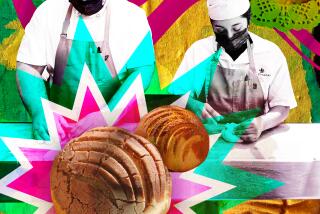Cooking Up Queen Conch in Turks and Caicos
- Share via
PROVIDENCIALES, Turks and Caicos Islands — Underwater, there seems to be little about a queen conch to fuel the sort of enthusiasm--culinary or otherwise--that this giant, helmet-shaped mollusk inspires back on land. As biologist Chuck Hesse put it, “A conch without its shell is not a pretty sight.”
Yet the queen conch--pronounced konk --has been a staple in the Caribbean for centuries, says Hesse, who’s in the conch-growing business in the Turks and Caicos, just north of Hispaniola.
And as Hesse and everyone else knows who has sampled a bowl of chowder, a palm-size fritter or a cracked conch steak, it takes on new meaning once properly prepared.
At its very best, the white meat approaches the taste of veal. By most counts, though, it resembles its cousin, the Pacific Coast abalone, in both texture and flavor.
“People back in the States may think of it as an appetizer, but down here the conch has a long tradition as an integral part of the natural resources,” Hesse says.
Hesse, whose commercial Caicos Conch Farm harvests adult conch from an 80-acre aquatic pasture on the Turks and Caicos island of Providenciales, traces the role of the giant mollusk back to pre-Columbian times.
“The Arawak (Indians) ate the conch and carved (demi-) gods out of its shell,” Hesse says. “For generations, natives throughout the region have been relying on the animal as a sustenance fishery.”
The fame of the queen conch was once known firsthand in Florida, where hardy settlers to the Keys used it as a major food source. Although conch chowder is today widely sold up and down the Keys, all of the conch meat must now be imported to the United States from places such as the Turks and Caicos, Colombia, Honduras, Belize and the islands of the Greater Antilles. While locals have dubbed the Keys the “Conch Republic,” there is scarcely a wild conch to be found in nearby Florida waters because of years of over-fishing.
The queen conch is found only in the Caribbean basin (the islands and coastal regions in and adjacent to the Caribbean Sea), the Keys and in an isolated area around Bermuda. While other types of large-shelled mollusks are used in conch-type dishes, the queen conch has the largest and arguably the most tender meat of all.
Since the Turks and Caicos only began to be developed recently, centuries-old fishing methods have survived well into the 1990s. Up until just a few years ago, fleets of hand-built, sail-powered wooden work boats fanned out from the shores in search of lobster, grouper, snapper and queen conch.
It is here, in the Caribbean and particularly in the conch-rich islands of the Turks and Caicos, that dishes made from the queen conch seem to take on the highest form. In fact, all things conch are so revered in this British Crown Colony--including the rare pink conch pearl--that the large mollusk even appears on the national seal.
Turks and Caicos is still undeveloped--a set of eight islands and 40 cays with a population of only 17,000 spread over just seven of the isles. Although the busiest island of Providenciales now has a Club Med and a fancy Ramada, leaders of these low-lying limestone clumps of land seem more interested in courting eco-tourism than glitzy, intensive development, a la Nassau.
Subsequently, the queen conch has lots of undisturbed clear, clean tropical water in which to hop about and make more conch. While wild harvests are slowly declining, the shellfish is still plentiful enough to be the country’s second-largest export item. Restaurants throughout the island chain have taken advantage of this fact, and most offer up the conch in some form, from simple chowders to more sophisticated sauce dishes.
One day, while waiting for the pilot to fuel up a small eight-seat twin-engine plane on the remote island of North Caicos, I wandered into the matchbox-size structure that serves as the International Airport. The office of the airport manager was empty, but the adjacent Super D Cafe, with its two tiny tables and stand-up bar, was doing a bustling business. At the top of the menu was none other than cracked conch ($5.50). Along with Haitian rum, it appeared to be a brisk seller at 10 in the morning.
Back on Providenciales--Americanized as Provo--I counted at least a dozen restaurants with conch on their menu. They are sprinkled from one end of the island to the other. Formal addresses are of minimal use. The best way to find them is to call the restaurants and get directions or ask locals or taxi drivers. There are few street signs and numbers here.
The list includes the expensive eatery called Le Deck on Grace Bay (local telephone 655-47), which advertises “French and native cuisine,” as well as Henry’s Roadrunner in Blue Hills. The Roadrunner, which brims with island character, even features a “Honky Night” in which all-you-can-eat conch, lobster and fish are on the menu. (From a ship-to-shore radio, call Henry’s at VHF Channel 16 for rates and times. There is no telephone.)
While the self-explanatory fritters and tomato-based chowders are best known back in the States--and are widely available locally--the more classic island fare is the cracked conch. Unlike the other dishes in which tiny bits of conch are chopped or ground, cracked conch requires that the entire foot muscle be turned into a flat steak. For that to happen properly, the conch must be as fresh as possible and not subjected to long periods at the bottom of a freezer. Should that take place, the conch’s curse is to turn as rubbery as a tire.
On Provo, there is probably no fresher conch available than at a small eatery that opened this spring at the Caicos Conch Farm itself. Here, the restaurant called the Conch Bar (call 65-330) is situated in a large wooden shed that was once used to nurture the animals during the early stages of their lives. With its deck outside overlooking the clear, green tropical waters of the conch pasture, the Conch Bar may be as close to conch enlightenment as a lover of the pink-lipped mollusk can get.
Cook Jacqueline Smith has brought a slew of local recipes with her from her home on Grand Turk Island. With help from Philippe Kunz, an effusive young expatriate Frenchman who serves as manager, Smith serves an ever-growing number of customers in the tiny six-table restaurant.
Many of the guests have also come here to take a guided tour of the Island Sea Centre, located at Leeward Going Through, which includes the conch farm, a gift shop with conch T-shirts (“Think Pink”) and a slide show starring the mollusk.
From a closet-size kitchen, Smith rolls out an entire retinue of conch dishes, including a salad of raw conch, sashimi, Creole, cracked, burger and, of course, chowder and fritters. There’s also a collection of conch “fingers,” which seem modeled on McNuggets. And here the combo platter has a little bit of everything. Dishes range from about $5 to $9.50. Everything, except the salad and raw, marinated sashimi, is fried island-style. French fries or the local dish of pigeon peas and rice come on the side. The one concession to the arteries of conch aficionados is the use of soybean oil.
That everything comes out tender and rather succulent is as much a testament to Smith’s cooking skills as it is to the fact that conch on the hoof are to be found by the thousands just outside her door.
Her classic dish, cracked conch, is created by taking a mollusk that has been freshly caught, cleaned and tenderized. Smith hints that the Conch Bar may have a mysterious tenderizing machine that flattens the foot muscle out like a pancake, and even scores it with crisscrossing cuts like carnivores might score a cube steak. Still, any hard-working cook can produce the same results by simply pounding the foot with a wooden mallet and then scoring it with a knife. (And Smith advises prospective cooks to marinate freezer-bound conch in lime juice before cooling.)
Smith sends her fresh conch straight into an egg-and-milk batter. From there, it acquires a dusting of seasoned bread crumbs. It is then deep-fried or pan-fried until it’s just brown on both sides. And there’s plenty of hot sauce on the table if you want it. The Conch Bar also sells cold beer and frosty drinks to quell the pangs of those who overdose on spicy sauce.
Ambition seems also to be poking its head into the Caribbean’s famous manana lifestyle here: Smith promises a recipe book with at least 20 island-style dishes--mostly conch--to arrive by next spring. By then, she says, she will have worked out the details so that visitors looking for structured guidance can even go back home and try cooking conch themselves. She advises them to keep the lime juice handy.
More to Read
Eat your way across L.A.
Get our weekly Tasting Notes newsletter for reviews, news and more.
You may occasionally receive promotional content from the Los Angeles Times.










